Commercial Roof Systems
Commercial Metal & Flat Roofing Experts
At Metal Roofing Specialists, we provide quality raised standing seam metal and flat roofing systems for commercial properties throughout Greater Dallas-Fort Worth. Our skilled team strives to be the best at what we do by offering an honest service that is priced fairly and taking extra care to ensure your satisfaction upon completion of your roofing project.
Flat roofs are roofing systems commonly found on commercial and industrial buildings that are characterized by their horizontal or nearly flat slope. Flat roofs offer several advantages for commercial properties, including cost-effectiveness, ease of installation, and the ability to utilize the rooftop space. These roofs are typically covered with materials such as built-up roofing (BUR), modified bitumen, EPDM rubber, TPO, PVC, or metal.
Metal Roofing Specialists, Inc. specializes in delivering superior craftsmanship and reliable service for all types of commercial properties. Contact us today to experience the unrivaled expertise of Metal Roofing Specialists, the best metal roofing company in Texas!
Schedule Your FREE Metal Roofing Estimate Today!
Our team uses a 24 hour answering service.
Standing Seam Metal Roof
Standing seam is a type of metal roofing system characterized by vertical metal panels with raised seams that interlock tightly, creating a sleek, modern appearance.
Advantages
Durability: Standing seam metal roofing is highly durable and can withstand extreme weather conditions, including heavy rain, snow, hail, and high winds. It is also resistant to fire, mildew, and rot, ensuring long-term protection for your home.
Longevity: With proper installation and maintenance, standing seam metal roofs can last for 50 years or more, significantly longer than traditional roofing materials like asphalt shingles.
Minimal Maintenance: Standing seam metal roofing requires minimal maintenance compared to some other roofing materials. Routine inspections and occasional cleaning are typically all that’s needed to keep the roof in optimal condition.
Energy Efficiency: Some standing seam metal roofing materials are coated with reflective finishes, helping to reduce heat absorption and keep the home cooler in hot weather, thereby lowering energy costs.
Aesthetic Appeal: Standing seam metal roofing offers a sleek, modern appearance that complements a wide range of architectural styles. It comes in various colors and finishes, allowing homeowners to achieve the desired look for their homes.
Disadvantages
Cost: Standing seam metal roofing can be more expensive than some other roofing materials upfront due to the higher quality materials and specialized installation required.
Noise: Standing seam metal roofing can be noisier during heavy rain or hailstorms compared to some other roofing materials, although proper insulation and underlayment can help reduce interior noise levels.
Installation Complexity: Standing seam metal roofing installation may be more complex than some other roofing materials, requiring specialized knowledge and skills, and potentially leading to higher installation costs.
Denting: Standing seam metal roofing is susceptible to denting from hail or falling debris, although thicker gauge metal and proper installation techniques can help minimize this risk.
Overview
Overall, standing seam metal roofing offers numerous benefits for homeowners, including durability, longevity, minimal maintenance, energy efficiency, and aesthetic appeal. However, it’s essential to consider potential drawbacks such as cost, noise, installation complexity, and denting when deciding whether standing seam metal roofing is the right choice for your home. Consulting with a professional roofing contractor can help you weigh the pros and cons and make an informed decision based on your specific needs and preferences.
Corrugated metal Roof
Corrugated metal roofing involves the use of metal sheets with a distinctive wavy pattern, known as corrugations, which provide strength and rigidity to the roofing material.
Advantages
Durability: Corrugated metal roofing is highly durable and can withstand extreme weather conditions, including heavy rain, snow, hail, and high winds. It is also resistant to fire, mildew, and rot, ensuring long-term protection for your home.
Longevity: With proper installation and maintenance, corrugated metal roofs can last for 50 years or more, significantly longer than traditional roofing materials like asphalt shingles.
Lightweight: Corrugated metal roofing is relatively lightweight compared to other roofing materials, putting less strain on the underlying structure of the home and potentially reducing construction costs.
Energy Efficiency: Some corrugated metal roofing materials are coated with reflective finishes, helping to reduce heat absorption and keep the home cooler in hot weather, thereby lowering energy costs.
Eco-Friendly: Corrugated metal roofing is often made from recycled materials and is fully recyclable at the end of its lifespan, making it an environmentally friendly roofing option.
Disadvantages
Noise: Corrugated metal roofing can be noisy during heavy rain or hailstorms, leading to increased interior noise levels unless proper insulation is installed.
Cost: While corrugated metal roofing can be cost-effective in the long run due to its durability and longevity, the initial installation cost may be higher than some other roofing materials.
Condensation: Without proper ventilation and insulation, condensation can form on the underside of corrugated metal roofing, potentially leading to moisture-related issues such as mold and mildew growth.
Denting: Corrugated metal roofing is susceptible to denting from hail or falling debris, although this can be mitigated by choosing thicker gauge metal or installing protective barriers.
Overview
Overall, corrugated metal roofing offers numerous benefits for homeowners, including durability, longevity, energy efficiency, and eco-friendliness. However, it’s essential to consider potential drawbacks such as noise, cost, condensation, and denting when deciding whether corrugated metal roofing is the right choice for your home. Consulting with a professional roofing contractor can help you weigh the pros and cons and make an informed decision based on your specific needs and preferences.
Metal Shingle Roofing
Metal shingle roofs are roofing materials designed to mimic the appearance of traditional roofing materials such as asphalt shingles, wood shakes, or slate tiles, while offering the durability and longevity of metal.
Types of Metal Shingles
There are several types of metal roofing shingles available, each offering unique aesthetics and performance characteristics. Some common types include:
Metal Shake Shingles: These shingles mimic the appearance of traditional wood shakes, offering a rustic and natural look while providing the durability and longevity of metal.
Metal Slate Shingles: Metal slate shingles replicate the look of natural slate tiles, offering a classic and elegant appearance without the weight and fragility of traditional slate.
Metal Tile Shingles: Metal tile shingles resemble traditional clay or concrete tiles, providing a timeless and sophisticated aesthetic while offering the durability and lightweight nature of metal.
Metal Shingle Panels: Metal shingle panels are available in various shapes and designs, including diamond, octagonal, and hexagonal patterns, offering versatility and customization options for homeowners.
Interlocking Metal Shingles: These shingles feature an interlocking design that provides added protection against wind uplift and water infiltration, making them ideal for areas prone to severe weather conditions.
Textured Metal Shingles: Textured metal shingles come in a variety of textures and finishes, including wood grain, stone texture, and hammered metal, offering a unique and visually appealing look for homes.
Each type of metal roofing shingle offers its own set of advantages and aesthetic appeal, allowing homeowners to choose the option that best suits their preferences and architectural style.
Advantages
Durability: Metal roofing shingles are highly durable and can withstand extreme weather conditions, including heavy rain, snow, hail, and high winds. They are also resistant to fire, mildew, and rot, ensuring long-term protection for your home.
Longevity: With proper installation and maintenance, metal roofing shingles can last for 50 years or more, significantly longer than traditional roofing materials like asphalt shingles.
Lightweight: Metal roofing shingles are lighter than traditional roofing materials like slate or concrete, putting less strain on the underlying structure of the home and potentially reducing construction costs.
Energy Efficiency: Some metal roofing shingles are coated with reflective finishes, helping to reduce heat absorption and keep the home cooler in hot weather, thereby lowering energy costs.
Aesthetic Appeal: Metal roofing shingles come in a variety of styles, colors, and textures, allowing homeowners to achieve the desired look for their homes while benefiting from the practical advantages of metal roofing.
Disadvantages
Cost: Metal roofing shingles can be more expensive than some other roofing materials upfront due to the higher quality materials and specialized installation required.
Noise: Metal roofing shingles can be noisier during heavy rain or hailstorms compared to some other roofing materials, although proper insulation and underlayment can help reduce interior noise levels.
Installation Complexity: Metal roofing shingle installation may be more complex than some other roofing materials, requiring specialized knowledge and skills, and potentially leading to higher installation costs.
Denting: Metal roofing shingles are susceptible to denting from hail or falling debris, although proper installation techniques can help minimize this risk.
Overview
Overall, metal roofing shingles offer numerous benefits for homeowners, including durability, longevity, energy efficiency, and aesthetic appeal. However, it’s essential to consider potential drawbacks such as cost, noise, installation complexity, and denting when deciding whether metal roofing shingles are the right choice for your home. Consulting with a professional roofing contractor can help you weigh the pros and cons and make an informed decision based on your specific needs and preferences.
Stone Coated Metal Roof
Stone-coated metal roofs involve metal roofing panels coated with a layer of stone chips or granules, providing the appearance of traditional roofing materials such as asphalt shingles, wood shakes, or clay tiles.
Advantages
Durability: Stone-coated metal roofing combines the strength and longevity of metal with the aesthetic appeal of traditional roofing materials, offering superior durability and resistance to weathering, including rain, wind, hail, and UV rays.
Longevity: With proper installation and maintenance, stone-coated metal roofs can last for 50 years or more, significantly longer than many other roofing materials.
Lightweight: Stone-coated metal roofing is lighter than traditional roofing materials like clay tiles or concrete, putting less stress on the underlying structure of the home and potentially reducing construction costs.
Fire Resistance: Metal roofing is inherently fire-resistant, and the stone coating adds an extra layer of protection, making stone-coated metal roofs highly resistant to fire damage.
Aesthetic Appeal: Stone-coated metal roofing comes in a variety of styles, colors, and textures, allowing homeowners to achieve the desired look for their homes while benefiting from the practical advantages of metal roofing.
Disadvantages
Cost: Stone-coated metal roofing can be more expensive than some other roofing materials upfront due to the additional manufacturing process and materials involved.
Noise: While stone-coated metal roofing is quieter than traditional metal roofing during rainstorms, it may still produce more noise than some other roofing materials, depending on the installation and insulation.
Maintenance: While stone-coated metal roofing requires minimal maintenance compared to some other roofing materials, it may still require occasional inspections and repairs to ensure optimal performance and longevity.
Installation Complexity: Stone-coated metal roofing installation may be more complex than traditional roofing materials, requiring specialized knowledge and skills, and potentially leading to higher installation costs.
Overview
Overall, stone-coated metal roofing offers numerous benefits for homeowners, including durability, longevity, fire resistance, aesthetic appeal, and relatively low maintenance requirements. However, it’s essential to consider potential drawbacks such as cost, noise, maintenance, and installation complexity when deciding whether stone-coated metal roofing is the right choice for your home. Consulting with a professional roofing contractor can help you weigh the pros and cons and make an informed decision based on your specific needs and preferences.
Commercial Metal Roofing
ONE OF THE MOST WIDELY USED FLAT ROOF SYSTEMS TODAY IS METAL
Metal roofing offers commercial properties a durable, cost-effective, and versatile solution for their roofing needs. With its exceptional longevity, metal roofing provides long-term protection against the elements, reducing the need for frequent maintenance and replacement. Trust Metal Roofing Specialists, Inc. to provide a commercial metal roofing system that offers unmatched protection, ensuring the safety and security of your building. With our top-notch materials and expert craftsmanship, we guarantee that your metal roof will be built to withstand the toughest weather conditions.
Types of Metal Roofs
Standing Seam Metal Roofing
- Standing seam roofs feature vertical metal panels with raised seams that interlock tightly, providing a sleek, modern appearance and superior weather resistance.
- Advantages: Excellent durability, weather resistance, and longevity. Minimal maintenance required. Energy-efficient options available with reflective coatings.
- Disadvantages: Higher initial cost compared to some other metal roofing types. Professional installation required.
Corrugated Metal Roofing
- Corrugated metal roofs consist of metal panels with a wavy pattern, known as corrugations, providing strength and rigidity.
- Advantages: Cost-effective option. Lightweight and easy to install. Good durability and weather resistance.
- Disadvantages: Limited design options compared to standing seam roofs. May be more prone to noise during heavy rain.
Metal Shingle Roofing
- Metal shingle roofs mimic the appearance of traditional roofing materials such as asphalt shingles, wood shakes, or slate tiles.
- Advantages: Aesthetic appeal with the durability and longevity of metal roofing. Lightweight and easy to install.
- Disadvantages: May be more expensive than other metal roofing options. Limited color and style options compared to standing seam roofs.
Metal Tile Roofing
- Metal tile roofs replicate the look of traditional clay or concrete tiles, offering a classic and elegant appearance with the durability of metal.
- Advantages: Aesthetic appeal with superior durability and weather resistance. Lightweight and easy to install.
- Disadvantages: Higher initial cost compared to some other metal roofing options. Limited color and style options.
Stone Coated Metal Roofing
- Stone coated metal roofs feature metal panels coated with a layer of stone chips or granules, providing the appearance of traditional roofing materials.
- Advantages: Aesthetic appeal with the durability and longevity of metal roofing. Good weather resistance.
- Disadvantages: Higher initial cost compared to some other metal roofing options. Limited color and style options.
Each type of commercial metal roofing system offers its own set of advantages and considerations, and the best choice depends on factors such as budget, aesthetic preferences, and performance requirements.
Composition & Installation
Metal Panels: Commercial metal roofs are typically constructed using metal panels or sheets that come in various profiles and thicknesses. Common profiles include standing seam, corrugated, ribbed, and shingle-style panels.
Substrate: The metal panels are installed over a roof substrate, which may consist of plywood, oriented strand board (OSB), or metal decking, depending on the building’s construction and requirements.
Attachment: Metal panels are attached to the roof substrate using fasteners, clips, or adhesive, depending on the installation method and manufacturer’s specifications.
Finish: Metal panels may be coated with paint, enamel, or other protective finishes to enhance durability, corrosion resistance, and aesthetic appeal.
Advantages
Durability: Metal roofing materials are highly durable and resistant to weathering, UV radiation, corrosion, and impact damage, making them suitable for long-term use in harsh environmental conditions.
Longevity: Metal roofs have a long lifespan, typically lasting 50 years or more with proper installation and maintenance, compared to 20-30 years for traditional roofing materials like asphalt shingles.
Energy Efficiency: Metal roofing materials reflect sunlight and heat, reducing heat absorption and lowering cooling costs in hot climates. They can also be installed with insulation layers to improve thermal performance and energy efficiency.
Sustainability: Metal roofing materials are recyclable at the end of their lifespan, reducing environmental impact and waste. They may also contain recycled content, further enhancing their sustainability credentials.
Design Flexibility: Metal roofing panels come in a variety of profiles, colors, and finishes, allowing for customization and architectural design flexibility to suit different building styles and aesthetics.
Disadvantages
Cost: Metal roofs can be more expensive upfront compared to traditional roofing materials like asphalt shingles. However, their long lifespan and durability often result in lower lifecycle costs.
Noise: Metal roofs can be noisy during heavy rain or hailstorms, although proper insulation and underlayment can help reduce interior noise levels.
Expansion and Contraction: Metal roofing materials expand and contract with temperature fluctuations, which can lead to noise, fastener fatigue, and potential leaks if not properly installed with expansion joints and allowances.
Denting: Metal roofs may be susceptible to denting from hail or falling debris, depending on the gauge and type of metal used. Thicker gauge metals and impact-resistant coatings can help mitigate this risk.
Overview
Overall, commercial metal roofs offer numerous advantages, including durability, longevity, energy efficiency, sustainability, and design flexibility. However, they may be more expensive upfront and require proper installation and maintenance to maximize performance and mitigate potential issues. Consulting with a professional roofing contractor can help determine if a commercial metal roof is the right choice for specific building requirements and budget considerations.
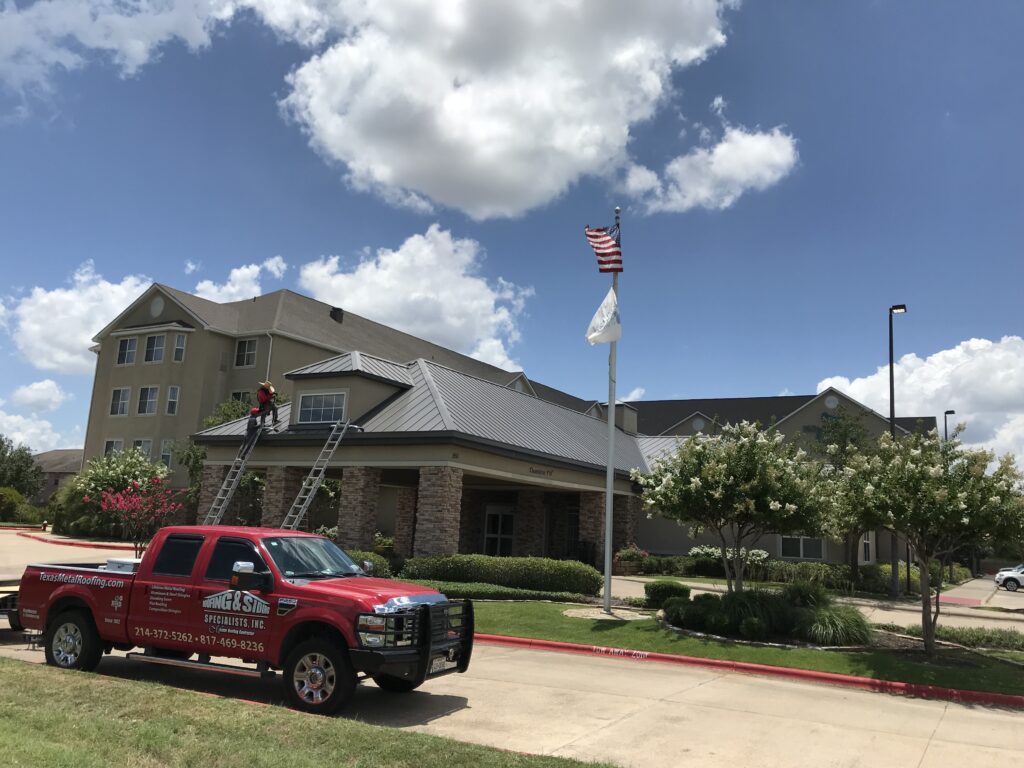

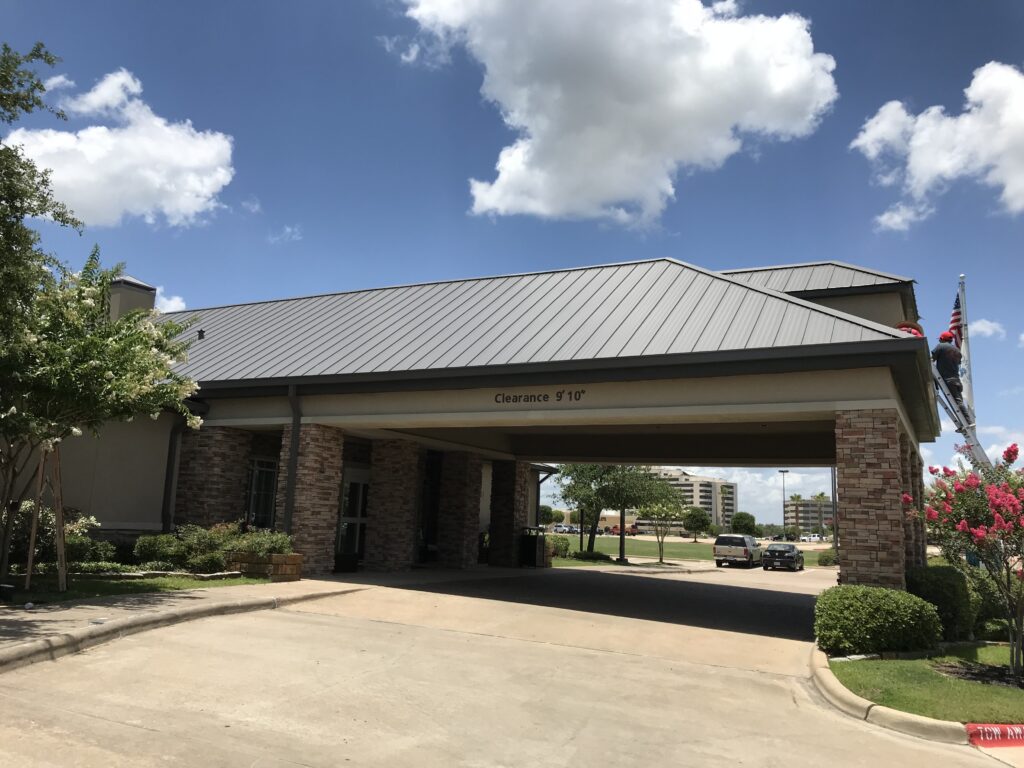
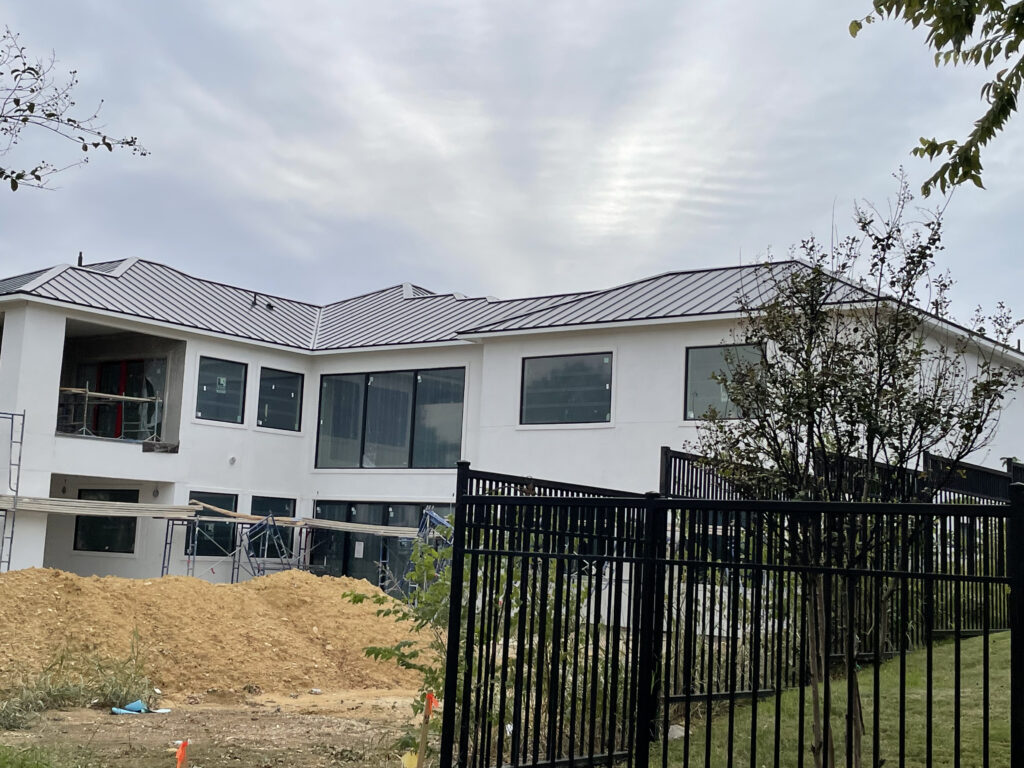
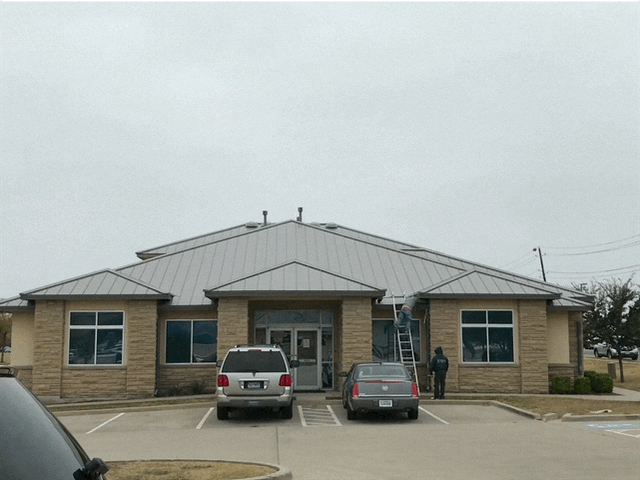
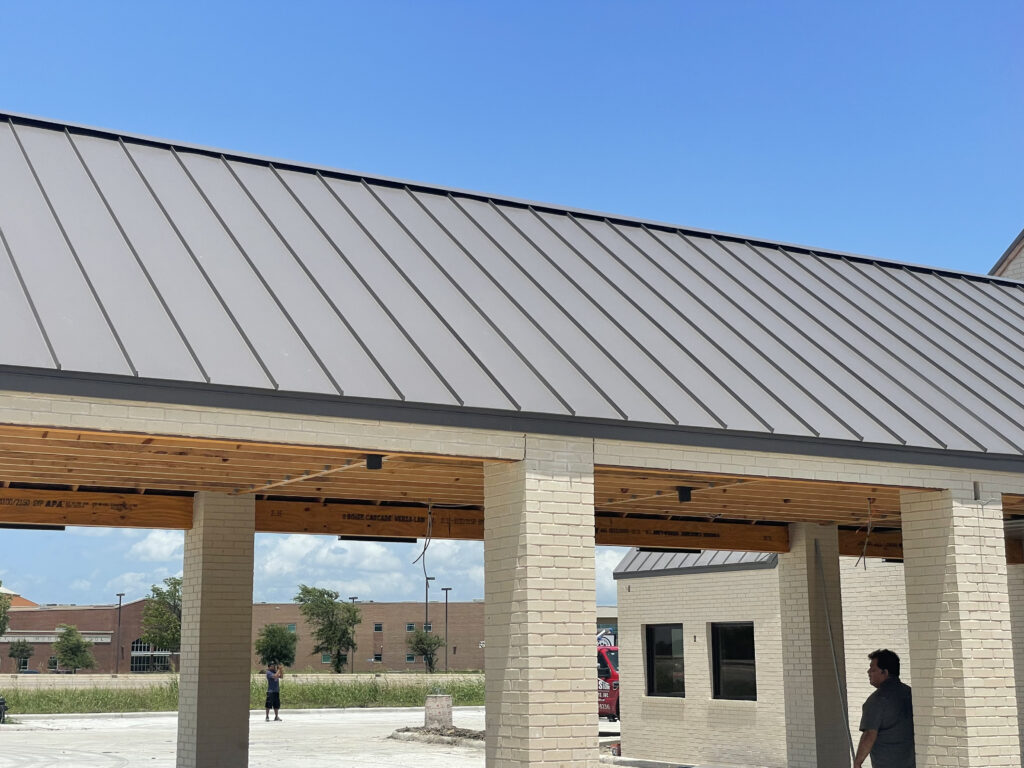
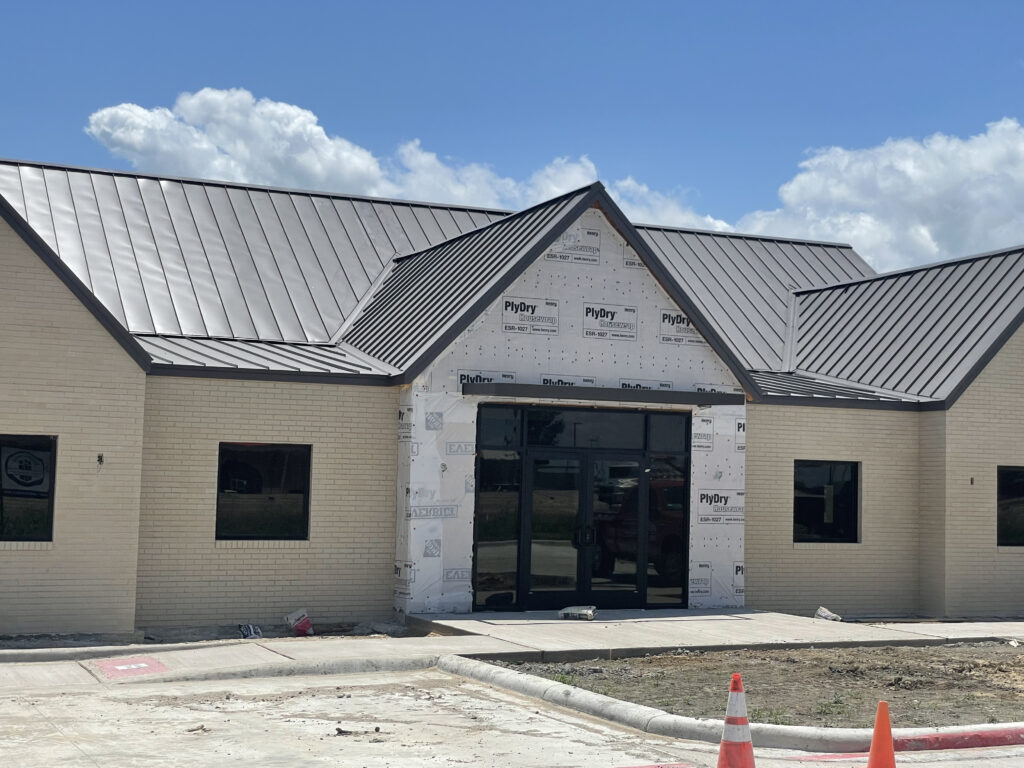
Get Your Free Metal Roofing Estimate Today!
BUILT-UP FLAT ROOFS
THE ORIGINAL ROOFING SYSTEM
A Built-Up Roofing (BUR) system, also known as a tar and gravel roof, is one of the oldest and most traditional types of flat roofing systems. It consists of multiple layers of bitumen (asphalt or coal tar) alternated with layers of reinforcing fabric, typically fiberglass or polyester, and topped with a layer of gravel or aggregate.
Composition & Installation
Base Layer: The base layer of a BUR roof consists of a vapor barrier or insulation board, which provides thermal protection and moisture resistance.
Bitumen Layers: Multiple layers of bitumen are applied to the roof substrate, typically using hot mopping or cold adhesive techniques. Each layer is followed by a layer of reinforcing fabric, which adds strength and stability to the roof system.
Surfacing Layer: The top layer of a BUR roof is typically covered with a layer of gravel or aggregate, which protects the underlying layers from UV radiation, weathering, and physical damage. Alternatively, a reflective coating may be applied to improve energy efficiency.
Advantages
Durability: BUR roofs are highly durable and resistant to UV radiation, weathering, punctures, and tears, making them suitable for long-term use in harsh environmental conditions.
Fire Resistance: The multiple layers of bitumen and reinforcing fabric provide excellent fire resistance, making BUR roofs ideal for commercial and industrial buildings where fire safety is a concern.
Thermal Protection: The multiple layers of insulation and bitumen in BUR roofs provide excellent thermal protection, reducing heat loss in the winter and heat gain in the summer, and lowering heating and cooling costs.
Cost-Effectiveness: BUR roofs offer excellent value for their durability and longevity, making them a cost-effective roofing option for commercial and industrial properties.
Easy Maintenance: BUR roofs are relatively easy to maintain, requiring periodic inspections and repairs to address issues such as leaks, cracks, and surface wear.
Disadvantages
Installation Complexity: BUR roofs require specialized equipment and training for installation, including hot mopping techniques for applying bitumen and reinforcing fabric, increasing labor costs and installation time.
Weight: BUR roofs can be heavy, especially when covered with gravel or aggregate, requiring structural support to bear the weight of the roof system.
Odor and Fumes: The materials used in BUR roofs, such as asphalt and coal tar, can emit odors and fumes during installation, which may be unpleasant or hazardous to workers and occupants.
Limited Aesthetic Options: BUR roofs are typically covered with gravel or aggregate, which may not be visually appealing compared to other roofing materials.
Overview
Overall, Built-Up Roofing (BUR) systems offer numerous advantages, including durability, fire resistance, thermal protection, cost-effectiveness, and easy maintenance. However, they may require specialized installation techniques, structural support, and considerations for odor and fumes during installation. Consulting with a professional roofing contractor can help determine if a BUR roof is the right choice for specific commercial or industrial roofing needs.
TPO ROOFING
Thermoplastic Polyolefin (TPO) roofing is a type of single-ply roofing membrane known for its durability, energy efficiency, and ease of installation.
Composition & Installation
TPO roofing membranes are composed of a blend of polypropylene and ethylene-propylene rubber, reinforced with polyester fabric or scrim for added strength and stability. TPO membranes are typically manufactured in large rolls and come in varying thicknesses, ranging from 45 to 80 mils (thousandths of an inch). TPO roofs are installed using several methods:
Fully Adhered: The TPO membrane is adhered directly to the roof substrate using a strong adhesive or bonding agent.
Mechanically Attached: The TPO membrane is attached to the roof substrate using mechanical fasteners such as screws or plates.
Ballasted: The TPO membrane is laid loose over the roof substrate and secured in place with ballast, such as gravel or pavers.
Advantages
Durability: TPO roofing membranes are highly durable and resistant to UV radiation, weathering, punctures, tears, and chemical exposure, making them suitable for long-term use in harsh environmental conditions.
Energy Efficiency: TPO roofs are available in white or light-colored formulations, which reflect sunlight and heat, reducing the heat island effect and lowering cooling costs.
Flexibility: TPO membranes remain flexible even in cold temperatures, allowing them to expand and contract with temperature fluctuations without cracking or tearing.
Easy Installation: TPO roofs are relatively easy to install compared to other roofing materials, reducing labor costs and installation time.
Cost-Effectiveness: TPO roofs offer excellent value for their durability, energy efficiency, and ease of installation, making them a cost-effective roofing option for commercial and residential properties.
Disadvantages
Seam Vulnerability: Seam integrity is crucial in TPO roofs, as seams can be vulnerable to separation or failure if not properly installed or maintained.
Limited Aesthetic Options: TPO membranes are typically available in white or light-colored formulations, limiting aesthetic options compared to other roofing materials.
Susceptibility to Heat Degradation: Some TPO membranes may be prone to heat degradation and shrinkage over time, especially if exposed to high temperatures during installation or operation.
Environmental Concerns: TPO membranes may contain additives or fillers that raise environmental concerns, such as VOC emissions during manufacturing or disposal.
Overview
Overall, TPO roofing offers numerous advantages, including durability, energy efficiency, flexibility, easy installation, and cost-effectiveness. However, proper installation and maintenance are essential to maximize the performance and longevity of TPO roofs, and considerations such as seam integrity and environmental concerns should be taken into account when choosing TPO roofing for a commercial or residential property. Consulting with a professional roofing contractor can help determine if TPO roofing is the right choice for specific roofing needs and requirements.
Modified BITUMEN FLAT ROOFS
HIGHLY REFLECTIVE & QUICK INSTALLATION MAKE THIS A GREAT OPTION
Modified bitumen roofing is a type of asphalt-based roofing material that incorporates modifiers such as styrene-butadiene-styrene (SBS) or atactic polypropylene (APP) to enhance its performance characteristics.
Composition & Installation
Modified bitumen roofing membranes are typically composed of multiple layers. The base layer consists of fiberglass or polyester reinforcement, which provides strength and stability. The reinforcement layer is coated with asphalt and modifiers, such as SBS or APP, to improve flexibility, durability, and weather resistance. The top layer may include granules or a reflective coating to enhance UV resistance and energy efficiency. Modified bitumen roofs are installed using several methods:
Torch-Applied: The modified bitumen membrane is heated with a torch during installation, allowing the asphalt to melt and bond to the substrate.
Cold-Applied: Adhesives or cold-applied asphalt are used to adhere the modified bitumen membrane to the roof substrate.
Self-Adhered: Peel-and-stick membranes are used, eliminating the need for adhesives or torches during installation.
Advantages
Durability: Modified bitumen roofing membranes are highly durable and resistant to UV radiation, weathering, and temperature fluctuations, making them suitable for long-term use in harsh environmental conditions.
Flexibility: The addition of modifiers such as SBS or APP enhances the flexibility of modified bitumen membranes, allowing them to accommodate building movement and temperature changes without cracking or splitting.
Ease of Repair: Modified bitumen roofs are relatively easy to repair compared to other roofing materials. Damaged areas can be patched or repaired using compatible materials and techniques.
Energy Efficiency: Reflective coatings or granules can be applied to modified bitumen membranes to improve energy efficiency by reducing heat absorption and lowering cooling costs.
Cost-Effectiveness: Modified bitumen roofs offer excellent value for their durability, performance, and longevity, making them a cost-effective roofing option for commercial and residential properties.
Disadvantages
Installation Complexity: Torch-applied modified bitumen membranes require specialized equipment and training for safe and proper installation, increasing labor costs and installation time.
Vulnerability to Damage: Modified bitumen roofs may be susceptible to punctures, tears, and seam failures if not installed correctly or exposed to harsh conditions.
Maintenance Requirements: Modified bitumen roofs require regular inspections and maintenance to ensure proper performance and prevent issues such as leaks, ponding water, and membrane degradation.
Limited Aesthetic Options: Modified bitumen membranes are typically available in black or gray, limiting aesthetic options compared to other roofing materials.
Overview
Overall, modified bitumen flat roofs offer numerous advantages, including durability, flexibility, ease of repair, energy efficiency, and cost-effectiveness. However, they may require specialized installation and maintenance, and they may be vulnerable to damage if not properly installed or maintained. Consulting with a professional roofing contractor can help determine if modified bitumen roofing is the right choice for a specific commercial or residential property.
EPDM ROOFS
THE FASTEST GROWING FLAT ROOF OPTION ON THE MARKET
Ethylene Propylene Diene Monomer (EPDM) is a type of synthetic rubber commonly used in flat roofing systems. An EPDM flat roof consists of a single-ply membrane made of EPDM rubber, which is adhered or mechanically fastened to the roof substrate to create a watertight seal.
Composition & Installation
EPDM flat roofs typically come in large rolls of membrane, ranging from 45 to 60 mils (thousandths of an inch) in thickness. The membrane is made of EPDM rubber, a highly durable and flexible material known for its resistance to weathering, UV radiation, ozone exposure, and temperature fluctuations. EPDM roofs are installed in several ways:
Fully Adhered: The EPDM membrane is adhered directly to the roof substrate using a strong adhesive or bonding agent.
Mechanically Fastened: The EPDM membrane is attached to the roof substrate using mechanical fasteners such as screws or nails.
Ballasted: The EPDM membrane is laid loose over the roof substrate and secured in place with ballast, such as gravel or pavers.
Advantages
Durability: EPDM rubber is highly durable and resistant to weathering, making it suitable for long-term use in harsh environmental conditions.
Flexibility: EPDM membranes remain flexible even in cold temperatures, allowing them to expand and contract with temperature fluctuations without cracking or tearing.
Easy Installation: EPDM roofs are relatively easy to install compared to other roofing materials, reducing labor costs and installation time.
Low Maintenance: EPDM roofs require minimal maintenance, typically consisting of periodic inspections and cleaning to remove debris.
Cost-Effectiveness: EPDM roofs are cost-effective compared to other flat roofing materials, offering excellent value for their durability and performance.
Disadvantages
Puncture Susceptibility: EPDM membranes may be susceptible to punctures from sharp objects such as branches, tools, or falling debris.
Seam Vulnerability: Seam integrity is crucial in EPDM flat roofs, as seams can be vulnerable to separation or failure if not properly installed or maintained.
Limited Aesthetic Options: EPDM roofs are typically available in black or white, limiting aesthetic options compared to other roofing materials.
Susceptibility to Solvents: EPDM rubber is susceptible to damage from certain solvents, oils, and chemicals, so care must be taken to avoid exposure during installation and maintenance.
Overview
Overall, EPDM flat roofs offer numerous advantages, including durability, flexibility, easy installation, low maintenance, and cost-effectiveness. However, they may be susceptible to punctures, seam vulnerabilities, and limited aesthetic options, so proper installation and maintenance are essential to maximize their performance and longevity.
Get Your Free Metal Roofing Estimate Today!
Finally, A DFW Roofing Company You Can Trust!
At Metal Roofing Specialists, our personal promise includes providing a FREE, no obligation estimate and showing you the best metal roofing options and materials to make your commercial roofing experience a pleasure. We will also take care of all the hassle and paperwork for you – from providing your estimate to dealing with insurance companies to installing your metal roof. Lastly, we will complete your commercial roofing project on time. No more guessing games or wondering where you are in the process of replacing or repairing your metal roof. We pride ourselves on delivering and installing your commercial roof in a timely manner, as promised.
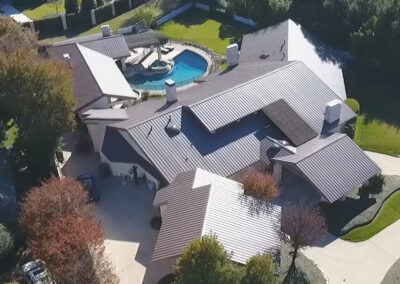
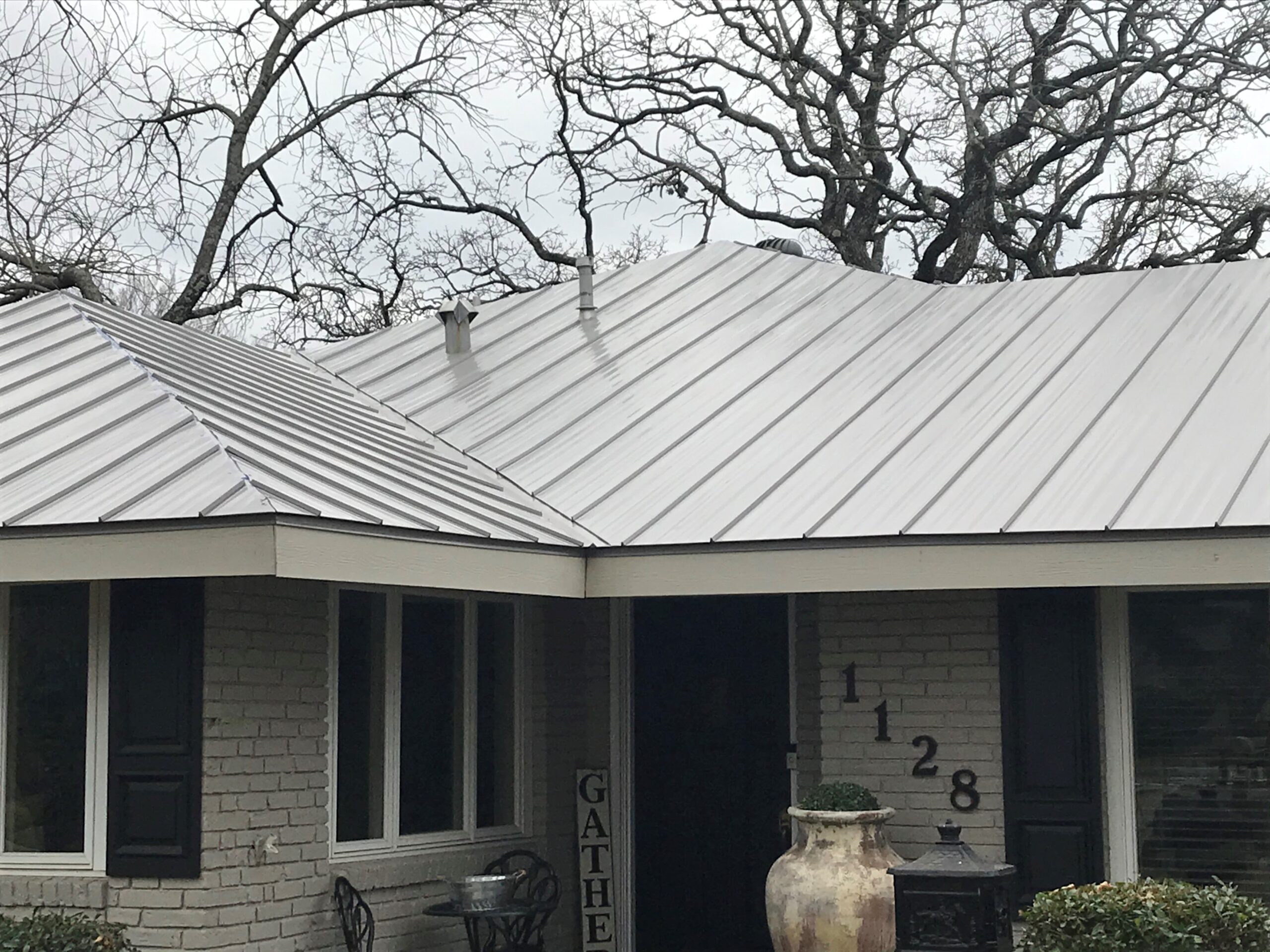
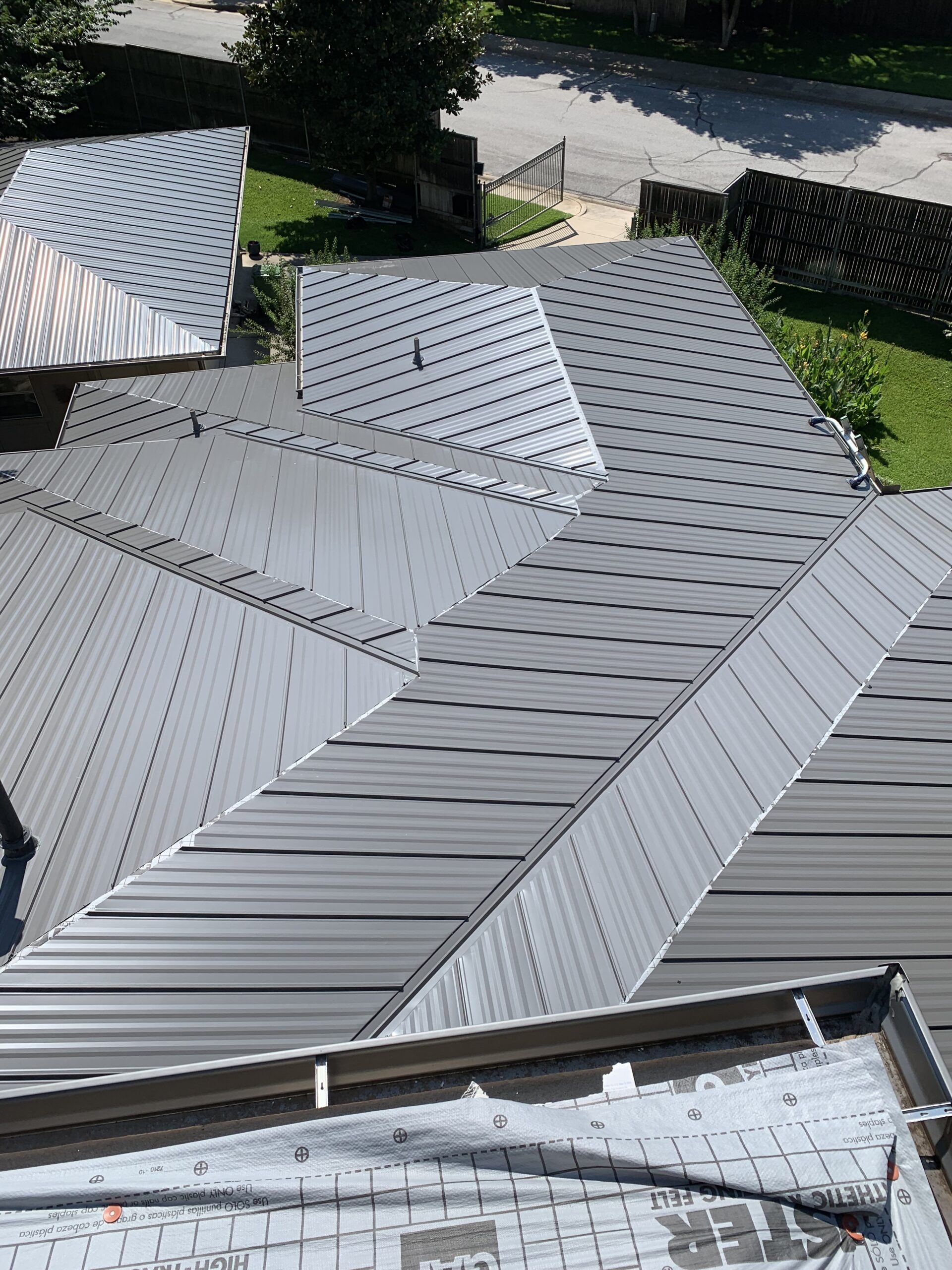
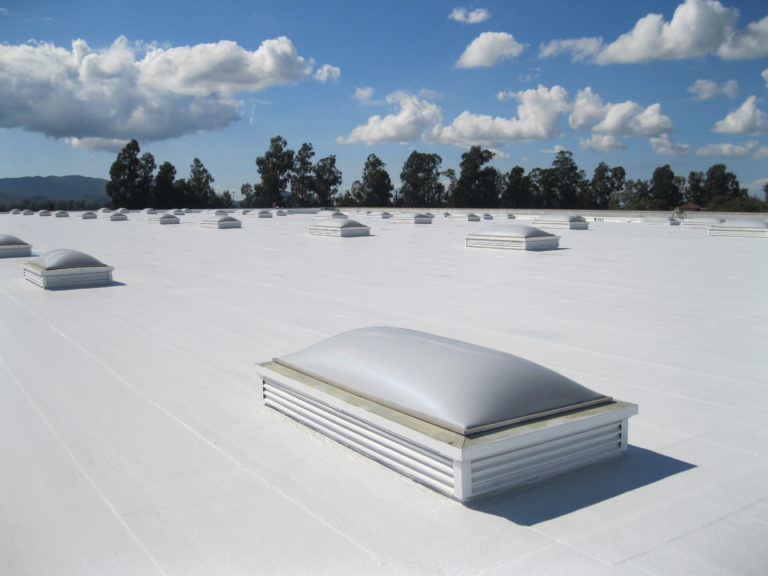
North Texas Service Areas
- Dallas
- Fort Worth
- Grand Prairie
- Denton
- Irving
- Mesquite
- McKinney
- Lewisville
- Frisco
- Keller
- Southlake
- Westlake
- Colleyville
- Argyle
- Tioga
- Arlington
- Grapevine
- Prosper
